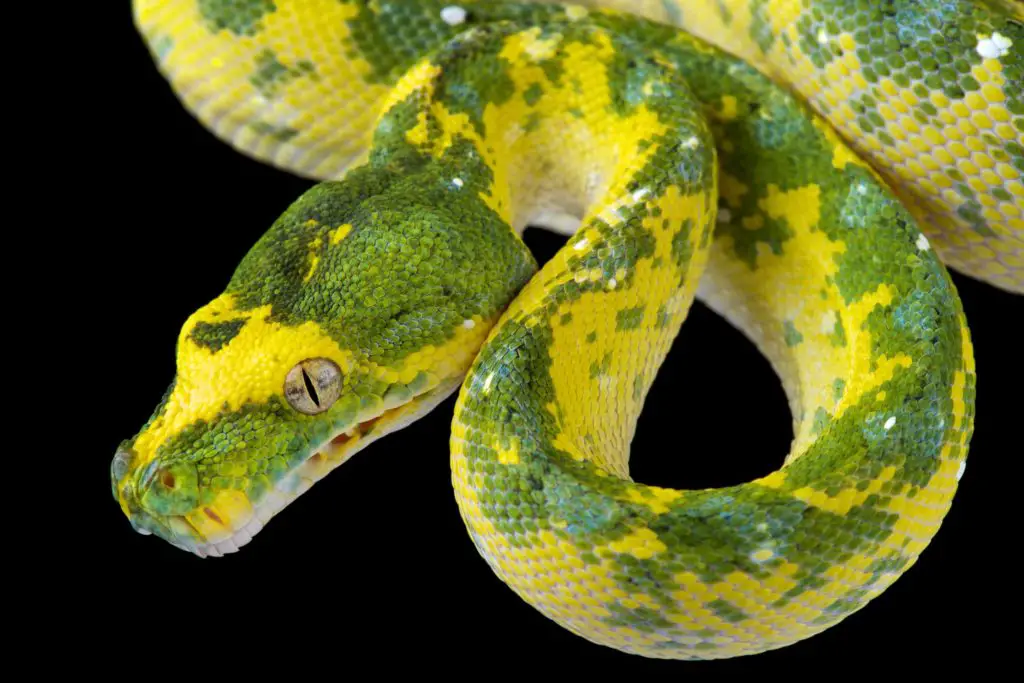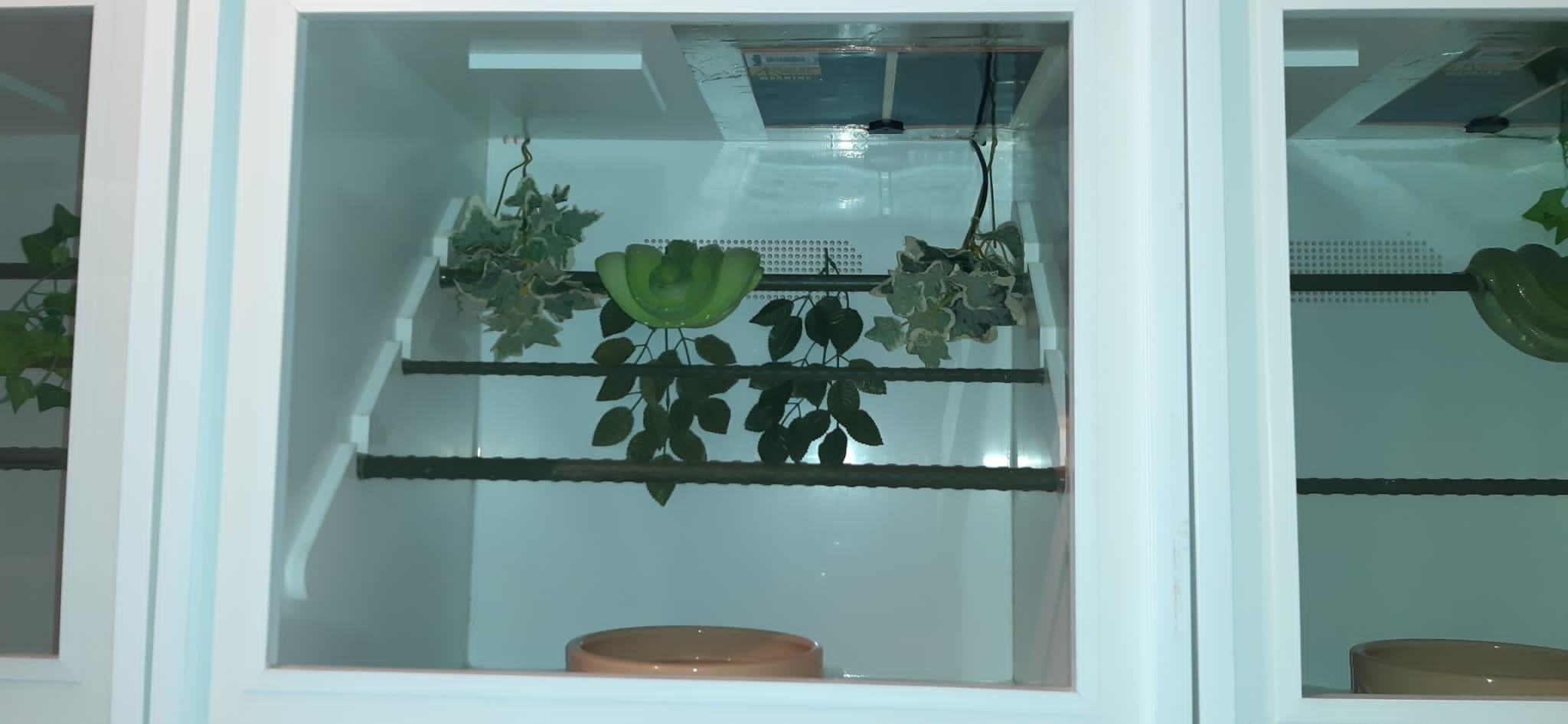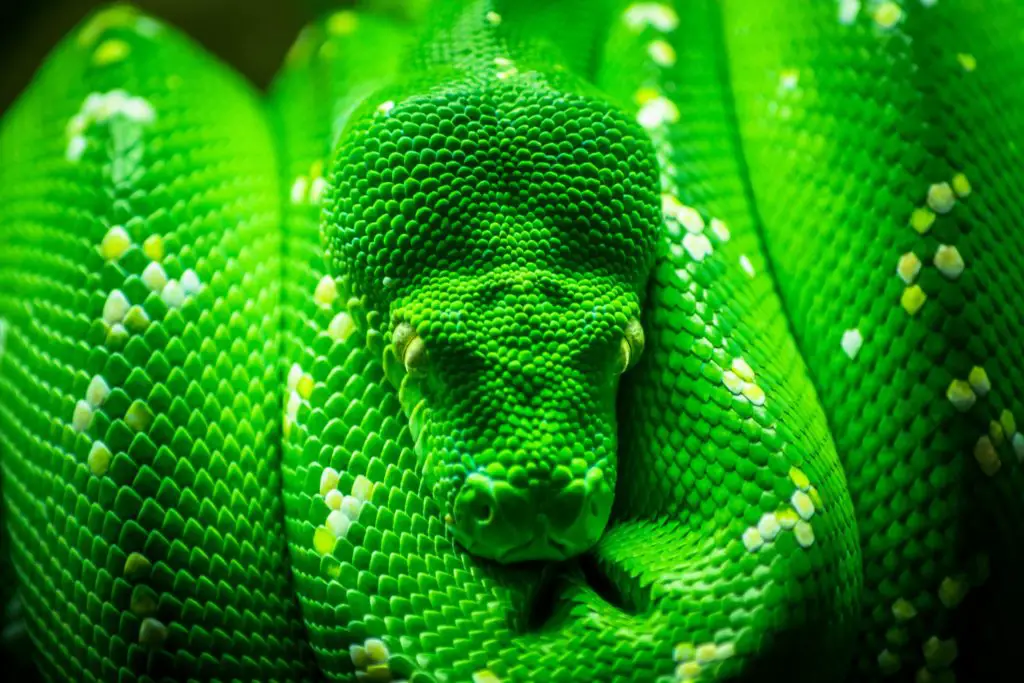Are Green Tree Pythons good pets? Despite their tricky reputation, they absolutely are. There’s just a few things you need to get right…
Last updated on February 1st, 2023 at 09:28 am
Green Tree Pythons are beautiful, low-maintenance pets – despite their aggressive reputation. Add to this the fact that they have low feeding requirements, and you get perhaps one of the most underrated pet snakes out there. All you have to do is make sure you get some basic husbandry right.
Do Green Tree Pythons make good pets?
Green Tree Pythons are one of the most unique python species in the world. Asides from being a striking green or blue colour as adults, they also display unique behaviours and adaptations that make them absolutely fascinating.
When you compare a Green Tree Python of either species (Morelia viridis and Morelia azurea) to ‘true’ pythons like the Ball Python, you notice that they have a few added features to say the least.
First, their tail is long and thin making it good for gripping branches, but also great for caudal luring. In fact, baby Green Tree Pythons use their tails as bait for small lizards, wriggling it like a worm until they get close enough to strike at.
Another feature that sets them apart is their ontogenetic colour change, which occurs by the time they reach around 24in (60cm) in length. Sometimes, they literally change colour over the course of a couple of weeks, going from maroon or yellow to green or blue.
Fascinating adaptations aside, these snakes are calm, beautiful animals that are actually reasonably easy to keep.

Are Green Tree Pythons aggressive?
Green Tree Pythons are a little jumpy, but not generally aggressive. The reason this myth stuck is because years ago, most of the ones available for sale were imported adults.
They had grown up in the wild, where you need to defend yourself. Then, they were shipped to the other side of the world, often in poor conditions. By the time we got them, they were often extremely stressed and yes, this did make a lot of them aggressive, at least to begin with.
These days, though, most of the Green Tree Pythons available from respectable dealers are captive-bred. Any experienced reptile enthusiast will tell you that the difference between wild-caught and captive-bred animals is like night and day.
If you buy a captive-bred Green Tree Python, and handle it with the care it deserves, it will more than likely become very tame.
Imports also had a range of other problems that you won’t see in captive-bred animals, including:
- Dehydration
- High amounts of Flagellates (Parasites in the Protozoa clade)
- External parasites (mites, ticks)
- Internal parasites (intestinal worms)
- Severe stress
- Anorexia

Green Tree Python Bite
Another reason the myth about these snakes being aggressive stuck is that their bites really hurt! Those people who got imported animals and were bitten didn’t forget about it quickly.
That said, they aren’t dangerous, but the bite hurts way more than a Ball Python or Corn Snake. This is because Green Tree Pythons have teeth that are proportionally much longer than those of terrestrial pythons, and sharply curved backwards.
In the wild, they hunt very agile prey in the tree tops. So far, there’s good evidence of them feeding on birds, reptiles, lizards and even frogs. These are all fast-moving animals and the best way to grab them securely – and not drop them – is to have long teeth. As I mention earlier, though, captive-bred Green Tree Pythons aren’t generally aggressive. In fact, they’re pretty laid-back.
This means that all you need to do to avoid ever having a close encounter with their specialised teeth is take the correct precautions when feeding. Always use tongs to give them their prey, and make sure those tongs are at least 12inches (30cm) long for young snakes, then at least 18inches (45cm) long for adults.
Handling
Green Tree Pythons are slow-moving, delicate animals that do not appreciate being startled. When handling, always keep it to a maximum of once a week, and take particular care when removing them from their perch.
The easiest way to do this is to chose an enclosure with built in removable perches. You can take these out of the enclosure and gently slide the snake off to handle it. If it resists too much, just put it back and try again another time.
If you don’t have removeable perches in your setup, you can simply try to shuffle the snake off of its perch by touching one side of it. When it starts to move away, you have the opportunity to pick it up.
The main thing to remember is these snakes have delicate tails, and are prone to stress from startling. Take it slow and steady.

Diet
Captive Green Tree Pythons do fine on a diet of mice and rats, depending on their size. Generally speaking, hatchlings do well on a diet of one pinkie mouse every 5 to 7 days.
As they approach adulthood, increase the size of the mice offered to hopper, then medium, then large. When your snakes are fully grown, you can offer two large mice or one small rat (if they’ll take it).
This is a very simple diet, but provides all the nutrients they need, just like it does for other popular pet snakes, like Bull Snakes, Ball Pythons and Common Boas. What you need to remember with Green Tree Pythons, however, is that they have a very slow metabolism due to their stationary habits.
As adults, they should only be fed once every 10-14 days, and too much food will cause them to get obese.
How big do Green Tree Pythons get?
There are many different localities of Green Tree Python, some of which are bigger than others (just like Volta Ball Pythons and regular Ball Pythons). That said, most of them fall between 4 to 5ft (1.2-1.5m) long when fully grown.
Occasionally, some individuals do reach 6ft (1.8m), and there have been reports of 7ft long GTPS. I just haven’t seen one yet…
What I would say is that even though this sounds quite big, I would only class these as medium sized snakes. A 5ft Boa Constrictor can be a big, heavy animal, but a 5ft Green Tree Python is lighter, more slender, and occupies a much smaller space when curled up on its perch.
Baby Green Tree Pythons are cute little snakes, at a slender 8 or 9 inches (20-23cm) long.
Enclosure guidelines
The one thing you need to get right when it comes to a GTP enclosure is the perch. There has to be a perch or this species will not do well!
This perch can be any horizontal branch or plastic tube – so long as it allows the snake to perch and sleep on it just like it would a small branch in the wild. Fortunately, there are PVC enclosures designed with a couple of perches built in – often removable ones too.
These enclosures are admittedly more expensive than a lot of terrariums, but they are really worth it if you want this snake to thrive. They also have the benefit of being hygienic and holding humidity extremely well.
I would recommend a PVC enclosure for adult and subadult Green Tree Pythons. Getting one will take away a lot of the guess-work, and you’ll be using exactly what most breeders do.
For babies, plastic tubs work well, so long as you can securely put some kind of perch in for them. Again, these makeshift enclosures are hygienic and really hold in humidity nicely. Take a look at the examples of both enclosure type below…


Humidity and water
Green Tree Pythons come from humid, tropical zones in the wild, namely northern Australia and Papua New Guinea (captive ones came from here). Despite this, they don’t need an enclosure that’s dripping wet.
A common misconception is that you should spray them all the time. This is a big mistake, and can in fact lead to both scale rot (necrotising dermatitis) and respiratory infections. Instead, just spray them enough to aim for an ambient humidity level of 70%. When they’re shedding, spray more often, and increase it to 80%.
In captivity, it’s hard to replicate the level of air movement and ventilation there is outdoors, so it’s pretty easy to get arboreal species too wet. Though tropical rainforests are indeed humid, they have a lot of air movement which attenuates it for animals above ground level.
An another common myth is that they won’t drink from a bowl. Though some of them are shy and you might not see them, most breeders now agree that Green Tree Pythons will drink from a bowl on a regular basis.
As such, always provide a medium-sized bowl of fresh water in the bottom of their enclosure. You will probably find that this also helps to stabilise the humidity in there, without spraying as much.
Heat
Like most snakes, Green Tree Pythons need a thermal gradient in their enclosure. The best way to do this is to have their heat source above the perch on one side of the enclosure. If they get too warm, they can move to other side, and vice-versa.
As far as heat sources go, high-power (high-capacity) heat mats are by far the best method. They give out gentle heat without drying out the air overly, and work great when fixed to the roof of one side of the enclosure. Always use them with a pulse-proportional thermostat, with its probe placed on or near the perch.
Ceramic heat emitters and heat lamps are awful for this species – making their humidity levels plummet. I know every other website will try to sell them to you, but the information I’m listing here comes direct from breeders.
For temperatures, aim for a basking area at 85-88f (29-31c), an ambient air temperature of 80-82f (26.7-27.7c) and a night-time drop of 5-8f (3-4.5c). No seasonal variation is needed.

Light
Like many of our popular pet snakes, Green Tree Pythons do fine without UV light, getting all the vitamins and calcium they need from healthy rodent prey. Nonetheless, they do need ambient light, just to replicate the day/night cycle.
This can be light from a window or inside their enclosure, just make sure that it mimics the day/night cycle at the equator. This means 12hours on, 12hours off, all year.
If you use a high-capacity heat mat for a heat source, but want to include light to make you enclosure look good then I recommend an LED light strip. These are cheap, easy to install, and give off very little heat.

The bottom line
Green Tree Pythons are definitely good pets. While they don’t tolerate quite as much handling as Corn Snakes, for example, the stories of them being aggressive are not correct. Nor are the old stories about them being extremely fragile. In fact, captive-bred GTPs are great pets, and can live long, healthy lives with a moderate level of care.
Really all you have to do is follow the guidelines in this article – paying close attention to enclosure type and humidity in particular – and you can easily keep this species healthy. Given the wide availability of products like high-capacity heat mats and PVC enclosures these days, it might be time to stop thinking of Green Tree Pythons as an “advanced” pet.
If they’ve peaked your interest, head over to our Green Tree Python husbandry guide to learn even more about them.
Summary and quick facts
| Temperature: | Basking area 85-88f (29-31c), ambient air temperature 80-82f (26.7-27.7c) |
| Humidity: | 70%. Daily spraying not always necessary, allow snake to dry out fully between sprays |
| Favourite food: | Mice and rats |
| Enclosure size: | 12in (30cm) for hatchlings. 2-3ft (60-90) wide by 3-4ft (90-120cm) tall for adults |
| Activity rythm: | Nocturnal |
| Lighting needs: | UVB not necessary but ambient should be provided |
